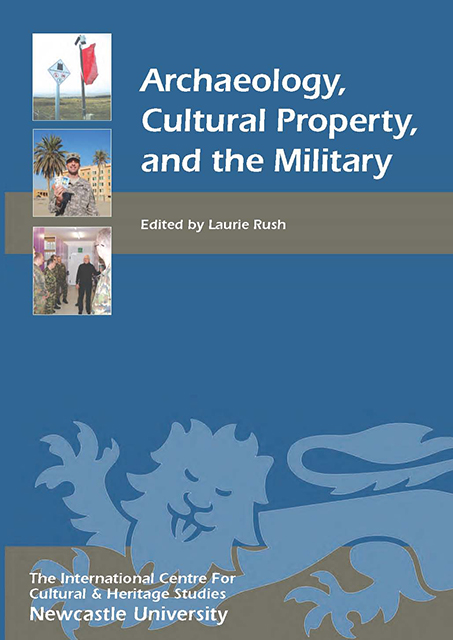Book contents
- Frontmatter
- Contents
- List of Illustrations: Figures and Tables
- Archaeology and the Military: An Introduction
- 1 The Obligations Contained in International Treaties of Armed Forces to Protect Cultural Heritage in Times of Armed Conflict
- 2 Rescuing Europe’s Cultural Heritage: The Role of the Allied Monuments Officers in World War II
- 3 The UK’s Training and Awareness Programme
- 4 US Army Civil Affairs: Protecting Cultural Property, Past and Future
- 5 Cultural Property Protection in the Event of Armed Conflict: Deploying Military Experts or Can White Men Sing the Blues?
- 6 Good Training and Good Practice: Protection of the Cultural Heritage on the UK Defence Training Estate
- 7 In-Theatre Soldier Training through Cultural Heritage Playing Cards: A US Department of Defense Example
- 8 Dealing the Heritage Hand: Establishing a United States Department of Defense Cultural Property Protection Program for Global Operations
- 9 Teaching Cultural Property Protection in the Middle East: The Central Command Historical/Cultural Advisory Group and International Efforts
- 10 Cultural Resources Data for Heritage Protection in Contingency Operations
- 11 Time not on my Side: Cultural Resource Management in Kirkuk, Iraq
- 12 US Military Support of Cultural Heritage Awareness and Preservation in Post-Conflict Iraq
- 13 Operation Heritage
- 14 Cultural Property Protection in the Event of Armed Conflict – Austrian Experiences
- 15 The Role of the Swiss Armed Forces in the Protection of Cultural Property
- 16 Preserving Global Heritage from Space in Times of War
- Appendix 1 1954 Hague Convention and its two Protocols
- Appendix 2 Author Biographies
- Index
8 - Dealing the Heritage Hand: Establishing a United States Department of Defense Cultural Property Protection Program for Global Operations
Published online by Cambridge University Press: 28 February 2023
- Frontmatter
- Contents
- List of Illustrations: Figures and Tables
- Archaeology and the Military: An Introduction
- 1 The Obligations Contained in International Treaties of Armed Forces to Protect Cultural Heritage in Times of Armed Conflict
- 2 Rescuing Europe’s Cultural Heritage: The Role of the Allied Monuments Officers in World War II
- 3 The UK’s Training and Awareness Programme
- 4 US Army Civil Affairs: Protecting Cultural Property, Past and Future
- 5 Cultural Property Protection in the Event of Armed Conflict: Deploying Military Experts or Can White Men Sing the Blues?
- 6 Good Training and Good Practice: Protection of the Cultural Heritage on the UK Defence Training Estate
- 7 In-Theatre Soldier Training through Cultural Heritage Playing Cards: A US Department of Defense Example
- 8 Dealing the Heritage Hand: Establishing a United States Department of Defense Cultural Property Protection Program for Global Operations
- 9 Teaching Cultural Property Protection in the Middle East: The Central Command Historical/Cultural Advisory Group and International Efforts
- 10 Cultural Resources Data for Heritage Protection in Contingency Operations
- 11 Time not on my Side: Cultural Resource Management in Kirkuk, Iraq
- 12 US Military Support of Cultural Heritage Awareness and Preservation in Post-Conflict Iraq
- 13 Operation Heritage
- 14 Cultural Property Protection in the Event of Armed Conflict – Austrian Experiences
- 15 The Role of the Swiss Armed Forces in the Protection of Cultural Property
- 16 Preserving Global Heritage from Space in Times of War
- Appendix 1 1954 Hague Convention and its two Protocols
- Appendix 2 Author Biographies
- Index
Summary
The United States Department of Defense (DoD) has one of the most robust and proactive cultural resources programmes in the world. Archaeologists working for all branches of the services have inventoried hundreds of thousands of acres, have discovered tens of thousands of archaeological sites, have set aside thousands of sites for preservation, and have made many significant archaeological discoveries on the North American continent and Hawaii. It is difficult to imagine a group of professionals who could have been more dismayed than US military archaeologists when the news of damage done to Babylon hit the global media. Since military archaeologists work for an organisation whose mantras include ‘we train as we fight’, it was difficult to understand how the US could have failed during global operations to implement the outstanding heritage ethics and practices routinely followed at home.
Ironically, domestic stewardship practices contributed in part to the lack of US preparation for successfully taking archaeological sites into consideration when operating abroad. Traditionally, in the US, the most important archaeological properties on military lands are put off-limits to military personnel as a preservation measure. As we continue to learn, we discovered that this approach limits opportunities to teach about the issue.
To address the problem of inadvertent damage to archaeological sites in-theatre, a group of military archaeologists realised that they would need to design and institute heritage awareness for personnel training to deploy. A second critical role that military archaeologists recognised they could play would be to help archaeologists who were subject matter experts on the affected sites and areas approach the Department of Defense to address the issue more effectively. A team composed of a military and an Old World archaeologist approached the Office of the Secretary of Defense (OSD) Legacy Resource Management Program to fund an ‘In-Theater Heritage Training Project’. Over the past three years, this project has successfully established an In-Theater Heritage Planning and Training Program. The ongoing project goal is to move toward a permanent office within the DoD that would have responsibility for planning and training for heritage issues related to any global operation. It is important to note that this project has focused on planning and awareness related to archaeological sites, historic structures and sacred places in the landscape.
- Type
- Chapter
- Information
- Archaeology, Cultural Property, and the Military , pp. 86 - 97Publisher: Boydell & BrewerPrint publication year: 2010
- 1
- Cited by



